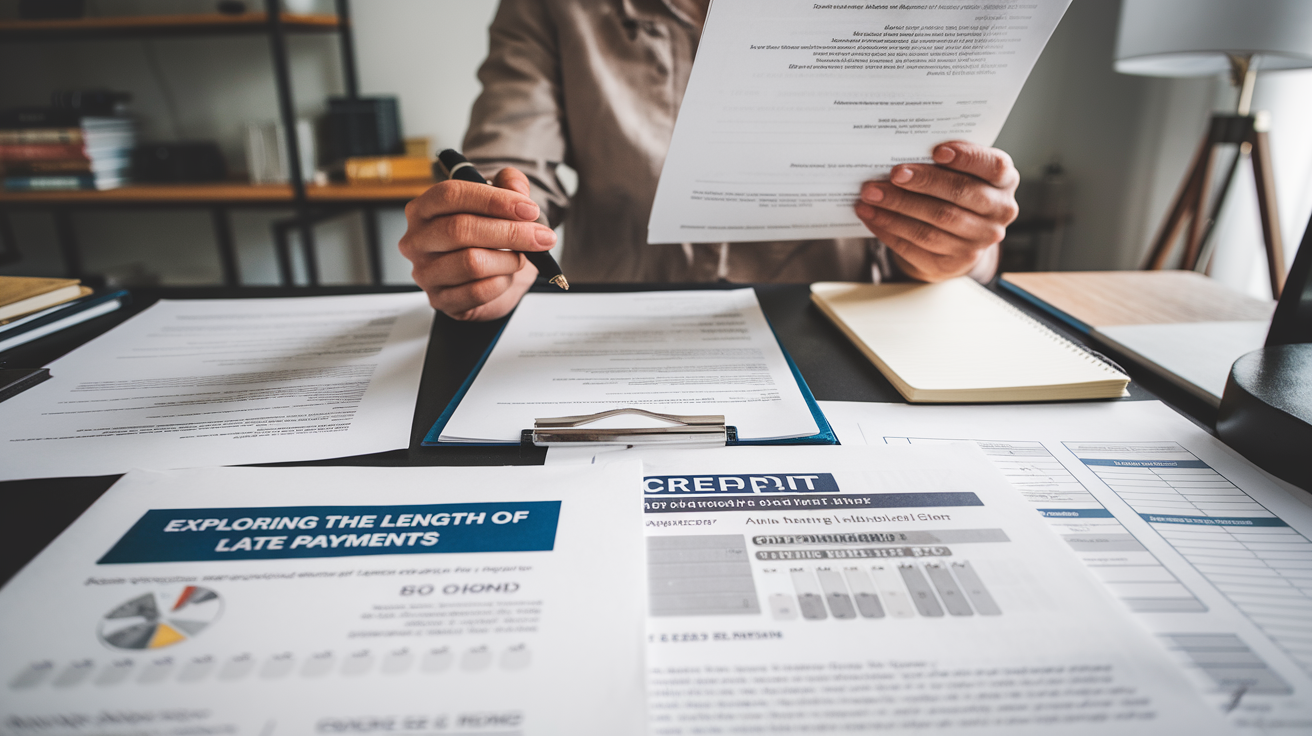-
Posted on: 09 Jan 2025

-
Understanding how long late payments impact your credit report is crucial for financial health. This guide explores the duration of these marks, their varying effects, and strategies to mitigate their influence, empowering you to take control of your credit future.
The Lingering Shadow: How Long Do Late Payments Stay on Your Credit Report?
When you miss a payment on a credit account, the consequences can feel immediate and significant. However, the true impact of a late payment isn't just a fleeting dip in your credit score; it's a mark that can persist on your credit report for an extended period. Understanding precisely how long these blemishes remain visible is key to effectively managing your credit and planning for future financial goals. In the United States, the Fair Credit Reporting Act (FCRA) dictates the maximum time negative information, including late payments, can be reported by credit bureaus. For most late payments, this duration is seven years from the date of the delinquency. This means that even after you've rectified the missed payment and resumed making timely contributions, the record of that lateness can continue to influence your creditworthiness for nearly a decade.
However, the seven-year rule isn't a universal clock that stops ticking at exactly 84 months. The severity of the late payment and its subsequent reporting can vary. For instance, a single 30-day late payment might have a less pronounced and shorter-lived effect compared to a 60-day or 90-day delinquency. Furthermore, the most severe financial transgressions, such as bankruptcies, can remain on your report for up to ten years. While late payments generally fall under the seven-year umbrella, it's essential to recognize that the damage they inflict isn't static. The initial hit to your credit score can be substantial, but as time progresses and you demonstrate consistent, responsible credit behavior, the negative influence of an old late payment gradually diminishes. By 2025, credit scoring models continue to prioritize recent activity, meaning a late payment from eight years ago will have far less impact than one from eight months ago.
The reporting period begins from the date of the delinquency. This is a critical distinction. It's not from the date you paid the overdue amount, nor is it from the date the creditor reported the delinquency. It's the date the account first became past due according to the terms of your agreement. For example, if your payment was due on January 15th and you paid it on January 20th, that's a 5-day delinquency. If the creditor reports this, the seven-year clock starts from January 15th. If you then fail to pay by February 15th, that's a 30-day delinquency, and the clock for that specific delinquency also starts from February 15th. Each instance of being past due can have its own reporting timeline, though creditors typically report a single, most severe delinquency status for an account.
Decoding the Severity: Different Tiers of Late Payments
Not all late payments are created equal in the eyes of credit bureaus and scoring models. The duration and severity of a late payment's impact are heavily influenced by how far past due the account becomes. Understanding these distinctions is crucial for assessing the damage and strategizing your credit repair efforts. The most common tiers of late payments, as reported to credit bureaus, are:
- 30-Day Late Payment: This is the least severe form of delinquency. It signifies that a payment was made between 1 and 30 days after the due date. While it will negatively affect your credit score, the impact is generally less significant than for longer delinquencies. A 30-day late payment will remain on your credit report for seven years from the date of the delinquency.
- 60-Day Late Payment: When a payment is between 31 and 60 days past due, it escalates the severity of the delinquency. This type of late payment will have a more substantial negative impact on your credit score than a 30-day late. Like its 30-day counterpart, a 60-day late payment will also be reported for seven years from the date of the delinquency.
- 90-Day Late Payment: Falling into this category means your payment is between 61 and 90 days past due. This is considered a serious delinquency and will significantly damage your credit score. The longer you go without making a payment, the more likely lenders are to view you as a higher risk. A 90-day late payment will remain on your credit report for seven years from the date of the delinquency.
- 120-Day Late Payment (and beyond): Any payment that is 91 days or more past due is considered a severe delinquency. The longer the period, the greater the damage to your credit score. These severe delinquencies can trigger more aggressive collection actions from the creditor. These will also be reported for seven years from the date of the delinquency.
It's important to note that once an account is marked as, for example, 90 days late, it typically stays at that severity level on your credit report, even if you subsequently make a payment. The reporting will reflect the most severe delinquency that occurred. The seven-year reporting period applies to all these tiers, but the magnitude of the score drop and the difficulty in obtaining new credit will increase with each escalation in the number of days past due.
For example, consider two individuals in 2025. Sarah missed a payment by 25 days on her credit card. John missed a payment by 95 days on his auto loan. While both marks will stay on their reports for seven years, Sarah's credit score might drop by 50-100 points, whereas John's could plummet by 150-250 points or more. Furthermore, lenders are much more likely to deny John new credit applications or offer him significantly higher interest rates compared to Sarah, even if their credit scores were identical before the late payments.
The Immediate Fallout: How Late Payments Affect Your Credit Score
The immediate aftermath of a late payment is often a noticeable drop in your credit score. Credit scoring models, such as FICO and VantageScore, place a significant emphasis on payment history, typically accounting for about 35% of your overall score. This makes late payments one of the most damaging events for your creditworthiness. The exact point drop varies widely depending on several factors, including your credit score before the delinquency, the severity of the late payment (30, 60, 90 days), and the type of credit account affected.
Here's a breakdown of how late payments typically impact credit scores:
- 30-Day Late: For someone with an excellent credit score (e.g., 780+), a single 30-day late payment could potentially cause a drop of 50-100 points. For someone with a good credit score (e.g., 680-739), the drop might be slightly less severe, perhaps 40-80 points.
- 60-Day Late: This more serious delinquency will result in a more significant score reduction. An excellent credit score holder might see a drop of 70-130 points, while a good credit score holder could experience a reduction of 60-110 points.
- 90-Day Late (and beyond): These severe delinquencies can cause the most dramatic score drops. An excellent credit score holder might see their score fall by 100-250 points or more. For someone with a good credit score, the drop could range from 90-200 points.
It's crucial to understand that these are estimates, and actual score changes can differ. For instance, if you have a history of perfect payments, a single 30-day late payment will likely have a more pronounced effect than if you have a few minor blemishes already on your report. By 2025, credit scoring algorithms are sophisticated, but the core principle remains: consistent, on-time payments are the bedrock of a good credit score.
Beyond the immediate score drop, late payments can also lead to:
- Increased Interest Rates: Creditors may increase the Annual Percentage Rate (APR) on your credit card or loan, making future borrowing more expensive. Some credit cards have a penalty APR that can be triggered by a late payment.
- Higher Insurance Premiums: In many states, insurance companies use credit-based insurance scores to determine premiums for auto and homeowners insurance. A late payment can negatively impact this score, leading to higher insurance costs.
- Difficulty Securing New Credit: Lenders view late payments as a sign of increased risk. This can make it harder to get approved for new credit cards, loans, mortgages, or even rental agreements.
- Reduced Credit Limits: For credit cards, a late payment might lead to a reduction in your available credit limit, further impacting your credit utilization ratio.
The cumulative effect of these consequences can make it challenging to achieve financial goals, from buying a home to securing favorable terms on a car loan. Therefore, addressing late payments promptly and preventing future occurrences is paramount.
Beyond the Clock: Factors Influencing How Long a Late Payment Hurts
While the seven-year reporting period for late payments is a standard guideline, the actual duration and intensity of its negative influence on your creditworthiness are not solely determined by the calendar. Several critical factors interact with the presence of a late payment to shape its ongoing impact. Understanding these nuances is vital for developing effective credit management strategies.
Here are the key factors that influence how long a late payment continues to hurt:
Severity of the Delinquency:
As discussed, a 30-day late payment has a less severe and potentially shorter-lived impact than a 90-day or 120-day late payment. While both remain on your report for seven years, the initial score drop is greater for more severe delinquencies, and their influence tends to linger longer in the eyes of sophisticated credit scoring models. A single 30-day lapse is often viewed differently than a pattern of severe neglect.
Frequency of Late Payments:
One isolated late payment is damaging, but a pattern of late payments is far more detrimental. If you have multiple late payments across different accounts, or recurring late payments on the same account, your credit score will suffer more significantly, and the negative effects will persist for a longer period. Credit scoring models heavily penalize inconsistency.
Credit Score Before the Late Payment:
Individuals with higher credit scores tend to experience a more substantial percentage drop in their score after a late payment. However, they also generally have a stronger foundation, which can aid in faster recovery. Someone with a lower credit score might see a less dramatic percentage drop, but the late payment could push them into a riskier tier, making recovery more challenging.
Time Since the Late Payment:
This is the most intuitive factor. The further in the past a late payment occurred, the less weight it carries in credit scoring models. Recent delinquencies have a much more immediate and pronounced negative effect than older ones. By 2025, credit algorithms are even more adept at valuing recent positive behavior over past mistakes.
Overall Credit Profile:
The rest of your credit report plays a significant role. If you have a long history of responsible credit use, low credit utilization, and a good mix of credit accounts, the negative impact of a single late payment may be somewhat mitigated. Conversely, if your credit profile is already thin or contains other negative marks, a late payment will exacerbate existing issues.
Type of Lender and Account:
Different lenders have varying risk tolerances. Some may be more forgiving of a single, older late payment than others. Similarly, a late payment on a mortgage or auto loan, which are typically secured loans, might be viewed more seriously than a late payment on an unsecured credit card.
Credit Utilization Ratio:
While not directly related to the late payment itself, a high credit utilization ratio (the amount of credit you're using compared to your total available credit) can amplify the negative impact of a late payment. Maintaining a low utilization ratio is always beneficial.
Consider this scenario in 2025: Maria has a credit score of 750 and one 30-day late payment from 18 months ago on a credit card. David has a credit score of 680 and a 90-day late payment from 6 months ago on his auto loan, along with a high credit utilization ratio. Even though Maria's late payment is older, David's more recent and severe delinquency, combined with his high utilization, will likely cause him more ongoing financial difficulty and a lower credit score.
Rebuilding Trust: Strategies to Minimize the Impact of Late Payments
Discovering a late payment on your credit report can be disheartening, but it's not a permanent financial sentence. Fortunately, there are proactive strategies you can employ to mitigate the damage and begin rebuilding your creditworthiness. The key is to address the situation head-on and demonstrate a renewed commitment to responsible financial behavior.
Here are effective strategies to minimize the impact of late payments:
Pay Down Balances Aggressively:
While a late payment itself remains on your report for seven years, its immediate negative impact can be lessened by improving other aspects of your credit profile. Reducing your credit utilization ratio is one of the most effective ways to do this. Aim to keep your utilization below 30%, and ideally below 10%. This shows lenders you are not overextended.
Make All Future Payments On Time:
This is the single most important step. Consistent, on-time payments are the cornerstone of good credit. Set up automatic payments or calendar reminders to ensure you never miss another due date. Even a single instance of consistent on-time payments after a lapse can begin to signal improved behavior to credit scoring models.
Negotiate with Creditors:
If you've recently experienced a late payment, especially if it was due to extenuating circumstances, contact your creditor immediately. Explain your situation and inquire if they would be willing to waive the late fee or, in rare cases, remove the late payment reporting from your credit report as a goodwill gesture. This is more likely to be successful if it's your first late payment on that account and you have a strong history with the creditor. By 2025, customer service initiatives may offer more flexibility for those demonstrating genuine hardship.
Consider a Secured Credit Card:
If your credit score has taken a significant hit, a secured credit card can be an excellent tool for rebuilding. You provide a cash deposit as collateral, which typically becomes your credit limit. Use this card for small, everyday purchases and pay the balance in full and on time each month. This demonstrates responsible credit management to the bureaus.
Obtain a Copy of Your Credit Report:
Regularly review your credit reports from all three major bureaus (Equifax, Experian, and TransUnion) at AnnualCreditReport.com. Check for any inaccuracies, such as incorrect late payment reporting or accounts you don't recognize. If you find errors, dispute them immediately with the credit bureau and the creditor.
Avoid Opening Too Many New Accounts:
While rebuilding credit, resist the urge to open numerous new credit accounts. Each application for credit results in a hard inquiry on your report, which can temporarily lower your score. Focus on managing the accounts you have responsibly.
Seek Credit Counseling:
If you're struggling with debt and managing payments, consider consulting a non-profit credit counseling agency. They can help you create a budget, negotiate with creditors, and develop a debt management plan.
By implementing these strategies consistently, you can actively work to minimize the ongoing negative impact of past late payments and steadily improve your credit score over time.
Can You Erase a Late Payment? Understanding Removal Possibilities
The prospect of removing a late payment from your credit report is a common and understandable desire for anyone seeking to improve their credit score. While the seven-year reporting period is a standard, there are specific circumstances and strategies that might lead to the removal of a late payment before that time. It's important to approach this with realistic expectations, as outright removal is not always guaranteed.
Here are the primary ways a late payment might be removed or its impact lessened:
Goodwill Removal:
This is perhaps the most common, albeit not guaranteed, method. If you have a strong history of on-time payments with a particular creditor and a single late payment occurred due to an unusual circumstance (e.g., a medical emergency, a natural disaster, or a simple oversight on your part), you can write a goodwill letter to the creditor. In this letter, politely explain the situation, emphasize your otherwise excellent payment history, and request that they remove the late payment notation from your credit report as a gesture of goodwill. Success here depends heavily on the creditor's policies and your relationship with them. By 2025, many lenders have established protocols for handling such requests, but persistence and politeness are key.
Disputing Inaccuracies:
The FCRA mandates that credit reports must be accurate. If you believe a late payment has been reported incorrectly, you have the right to dispute it with the credit bureaus (Equifax, Experian, and TransUnion). Common reasons for disputing include:
- The payment was actually made on time, and the creditor reported it late in error.
- The late payment is for an account you never opened or authorized.
- The creditor failed to report the payment accurately (e.g., reported 90 days late when it was only 30 days late).
To dispute, you'll need to provide evidence supporting your claim. The credit bureau is required to investigate your dispute within a reasonable timeframe (typically 30 days). If they find the information is inaccurate or unsubstantiated, they must remove it from your report.
Settlement and Debt Validation:
If a debt collector is reporting a late payment for a debt that is in collections, you can request debt validation. This requires the collector to prove they have the right to collect the debt and that the amount is accurate. If they cannot provide sufficient proof, the debt and associated negative marks may need to be removed. Similarly, if you settle a debt for less than the full amount owed, the late payment might still remain, but the status of the account will be updated to "settled." However, some debt settlement companies may negotiate the removal of the late payment as part of the settlement, though this is less common.
Statute of Limitations and Reporting Limits:
While late payments are generally reported for seven years, this period is dictated by the FCRA. Once the seven-year mark is reached, the credit bureaus are legally obligated to remove the information. There is no way to expedite this removal beyond the statutory limit unless it's due to an error or successful dispute.
Credit Repair Services:
Be cautious when considering credit repair services. While some legitimate services can help you identify inaccuracies and navigate the dispute process, many are scams that charge high fees for services you can perform yourself. Always research a credit repair company thoroughly and understand their fees and methods before engaging their services. By 2025, regulatory oversight of credit repair services has increased, but vigilance is still recommended.
It's crucial to remember that the most reliable way to improve your credit is through consistent, positive financial behavior. While seeking removal of inaccuracies or goodwill gestures can be beneficial, focusing on making timely payments and managing your credit responsibly will have the most significant long-term impact.
Proactive Protection: Preventing Future Late Payments
The best defense against the negative consequences of late payments is to prevent them from occurring in the first place. By implementing a few proactive strategies, you can significantly reduce the risk of missing a payment and protect your credit score. These methods focus on organization, automation, and awareness.
Here are essential steps to prevent future late payments:
Create a Budget and Track Expenses:
A clear understanding of your income and expenses is fundamental. Develop a realistic budget that allocates funds for all your financial obligations, including loan payments, credit card bills, and utilities. Regularly tracking your spending helps identify potential shortfalls before they impact your ability to make payments.
Set Up Automatic Payments:
This is one of the most effective ways to ensure timely payments. Most lenders and service providers offer automatic payment options. You can set them up to deduct the minimum payment or the full balance from your bank account on or before the due date. Ensure you have sufficient funds in your account to cover these automatic deductions.
Use Payment Reminders:
If automatic payments aren't feasible or you prefer more control, utilize calendar alerts, smartphone apps, or even simple sticky notes to remind yourself of upcoming due dates. Many banking apps and financial management tools offer customizable payment reminders.
Consolidate Due Dates:
If possible, try to align your bill due dates to occur around the same time each month, ideally after you receive your paycheck. This simplifies tracking and reduces the likelihood of missing one among many scattered deadlines. You can often request a one-time adjustment to your due date with your creditors.
Maintain an Emergency Fund:
Unexpected expenses can derail even the best financial plans. Building an emergency fund of 3-6 months' worth of living expenses can provide a buffer during unforeseen circumstances, preventing you from having to choose between essential bills and other financial obligations.
Understand Your Credit Terms:
Be aware of the due dates, grace periods, and any specific payment policies for each of your credit accounts. Missing a payment due to a misunderstanding of terms can be just as damaging as an intentional oversight. By 2025, digital statements and online portals make accessing this information easier than ever.
Communicate with Creditors:
If you anticipate difficulty making a payment, contact your creditor *before* the due date. Many lenders are willing to work with customers experiencing temporary financial hardship, perhaps by offering a payment plan or a temporary deferral. Proactive communication can often prevent a delinquency from being reported.
Review Statements Regularly:
Don't just pay bills; review your statements for accuracy and to ensure you're aware of upcoming payment amounts and due dates. This also helps catch any fraudulent activity.
By adopting these preventative measures, you can build a robust system that safeguards against late payments, ensuring your credit report remains a testament to your financial responsibility.
The Road to Recovery: Long-Term Credit Health After Late Payments
Experiencing late payments can feel like a significant setback, but it doesn't have to define your financial future. The journey to restoring and enhancing your long-term credit health after such an event is a marathon, not a sprint, requiring consistent effort and strategic financial management. The good news is that credit scoring models are designed to reward positive behavior over time, meaning past mistakes gradually fade in significance as you demonstrate reliability.
Here's how to focus on long-term credit health after late payments:
Prioritize Consistent On-Time Payments:
This cannot be overstated. Making every payment on time, every single month, is the most impactful action you can take. This builds a positive payment history, which is the largest factor in credit scoring. Over time, a consistent record of punctuality will outweigh the negative impact of older late payments.
Maintain Low Credit Utilization:
As mentioned previously, keeping your credit utilization ratio low (ideally below 30%, and even better below 10%) demonstrates that you are not over-reliant on credit. This is a key indicator of financial stability and can significantly boost your score as you recover from past delinquencies.
Diversify Your Credit Mix Responsibly:
A healthy credit mix, which includes different types of credit like credit cards, installment loans (e.g., auto loans, mortgages), and potentially a personal loan, can positively influence your score. However, avoid opening new accounts solely for the sake of mix; ensure any new credit is needed and can be managed responsibly.
Monitor Your Credit Reports Regularly:
Continuously checking your credit reports from Equifax, Experian, and TransUnion allows you to track your progress, identify any new negative information, and dispute any errors promptly. By 2025, many free services offer credit monitoring, making this more accessible than ever.
Avoid Unnecessary Credit Inquiries:
Each application for new credit typically results in a hard inquiry, which can slightly lower your score. Limit applications to when you genuinely need new credit and are likely to be approved.
Build a Long Credit History:
The length of your credit history is another factor in credit scoring. The longer you have managed credit accounts responsibly, the more positive data points you provide to scoring models. Avoid closing old, unused credit accounts if they have a positive payment history, as this can shorten your average account age.
Consider a Credit-Builder Loan:
These are small loans designed specifically to help individuals build or rebuild credit. The loan amount is held in an account and released to you after you've made all the payments. The payments are reported to credit bureaus, helping to establish a positive payment history.
The key takeaway for long-term credit health is consistency and patience. While a late payment can be a significant hurdle, it is not insurmountable. By focusing on responsible financial habits, diligently monitoring your credit, and understanding the factors that influence your score, you can effectively navigate the recovery process and build a strong, resilient credit profile for years to come.
In conclusion, understanding the duration and impact of late payments on your credit report is paramount for financial well-being. While a late payment can linger for up to seven years, its influence wanes over time, especially when countered by consistent on-time payments and responsible credit management. By proactively preventing future lapses, disputing inaccuracies, and focusing on building a positive credit history, you can effectively mitigate the damage and pave the way for a healthier financial future. Take control of your credit today by implementing these proven strategies.
Faq
Q1: If I pay my bill a day or two late, will it be reported?
Generally, no. Most lenders have a grace period, typically 15 days, after the due date before they consider a payment late and report it to the credit bureaus. However, you will likely still incur a late fee from the lender. Always check your specific loan or credit card agreement for details.
Q2: Does a single late payment significantly damage my credit score?
Yes, a single late payment can cause a noticeable drop in your credit score, often by 50-100 points, especially if your score was high to begin with. The impact lessens over time, but it remains on your report for seven years.
Q3: What's the difference between a 30-day late and a 60-day late payment on my report?
Both remain on your report for seven years. However, a 60-day late payment is considered more severe than a 30-day late payment. It will have a more significant negative impact on your credit score and signal a higher risk to lenders.
Q4: Can I negotiate to have a late payment removed from my credit report?
It's possible, especially if it's a first-time occurrence and you have a good payment history with the lender. You can try asking for a "goodwill adjustment" or "courtesy removal." While lenders are not obligated to remove it, some may agree, particularly if you explain your situation and have since rectified the payment.
Q5: If a late payment falls off my report after 7 years, does it stop affecting my score immediately?
Yes, once a negative item like a late payment is removed from your credit report after the seven-year period, it no longer directly affects your credit score calculation. However, lenders may still consider very old negative history during their underwriting process for significant loans like mortgages, though its weight is significantly reduced.
Q6: How do recent changes in medical debt reporting affect late payments?
As of 2023/2024, many unpaid medical debts under a certain threshold (e.g., $500) are no longer reported on credit reports if they are still with the original provider. However, if a medical bill is sent to a collection agency, it will be reported and follow the standard seven-year reporting period from the original delinquency date. This change primarily impacts unpaid medical bills, not other types of late payments.











